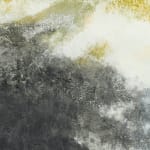Genbei Kamei
Honryu (Torrent), 1954
Two-panel folding screen; mineral colors on paper
Size 66¾ x 84½ in. (169.5 x 214.5 cm)
T-4570
Further images
Signed Gen and sealed Genbei With manuscript label on reverse Honryu 1954nen aki Seiryuten shuppin Kamei Genbei saku (Honryu [Torrent], Shown at the Seiryu[sha] Exhibition, Fall 1954, by Kamei Genbei)...
Signed Gen and sealed Genbei
With manuscript label on reverse Honryu 1954nen aki Seiryuten shuppin Kamei Genbei saku (Honryu [Torrent], Shown at the Seiryu[sha] Exhibition, Fall 1954, by Kamei Genbei)
Exhibited: Seiryusha, Tokyo, 1954
Born in Wakayama Prefecture in 1901, Kamei first took the artist name Tobei but later, in the year before he painted the present screen, changed it to Genbei. In 1919 he moved to Kyoto and trained as a Nihonga painter, achieving early success and having a work, Spring View, selected for the Shotaku Taishi exhibition, a major national event held in 1926. Kamei is perhaps better known today, as a print artist and founding member of the Kyoto Sosaku Hanga Kyokai (Kyoto Creative Print Association), whose members were directly involved in every stage of a print’s creation, from design to carving to printing. He showed prints at several of the most prestigious salons of the pre-war period including the Teiten national exhibition and exhibitions organized by the Shun’yokai; among his more popular print images was the first in an uncompleted series entitled Twelve Hours of a Cinema Actress. Starting in 1937 until its dissolution in 1966, he exhibited his paintings with the Seiryusha association, founded by Kawabata Ryushi (1885–1966), another native of Wakayama Prefecture, who championed large-scale works and bold compositions. Kamei became an associate of Seiryusha in 1942, graduating to full membership in 1950 and receiving many awards for his work.
The present screen painting, very much in line with the Seiryusha hosue style and stylistically a very far cry from the naïve landscape paintings or racy prints of his earlier period, is one of two works that Kamei is known to have exhibited at Seiryusha in 1954.
With manuscript label on reverse Honryu 1954nen aki Seiryuten shuppin Kamei Genbei saku (Honryu [Torrent], Shown at the Seiryu[sha] Exhibition, Fall 1954, by Kamei Genbei)
Exhibited: Seiryusha, Tokyo, 1954
Born in Wakayama Prefecture in 1901, Kamei first took the artist name Tobei but later, in the year before he painted the present screen, changed it to Genbei. In 1919 he moved to Kyoto and trained as a Nihonga painter, achieving early success and having a work, Spring View, selected for the Shotaku Taishi exhibition, a major national event held in 1926. Kamei is perhaps better known today, as a print artist and founding member of the Kyoto Sosaku Hanga Kyokai (Kyoto Creative Print Association), whose members were directly involved in every stage of a print’s creation, from design to carving to printing. He showed prints at several of the most prestigious salons of the pre-war period including the Teiten national exhibition and exhibitions organized by the Shun’yokai; among his more popular print images was the first in an uncompleted series entitled Twelve Hours of a Cinema Actress. Starting in 1937 until its dissolution in 1966, he exhibited his paintings with the Seiryusha association, founded by Kawabata Ryushi (1885–1966), another native of Wakayama Prefecture, who championed large-scale works and bold compositions. Kamei became an associate of Seiryusha in 1942, graduating to full membership in 1950 and receiving many awards for his work.
The present screen painting, very much in line with the Seiryusha hosue style and stylistically a very far cry from the naïve landscape paintings or racy prints of his earlier period, is one of two works that Kamei is known to have exhibited at Seiryusha in 1954.











